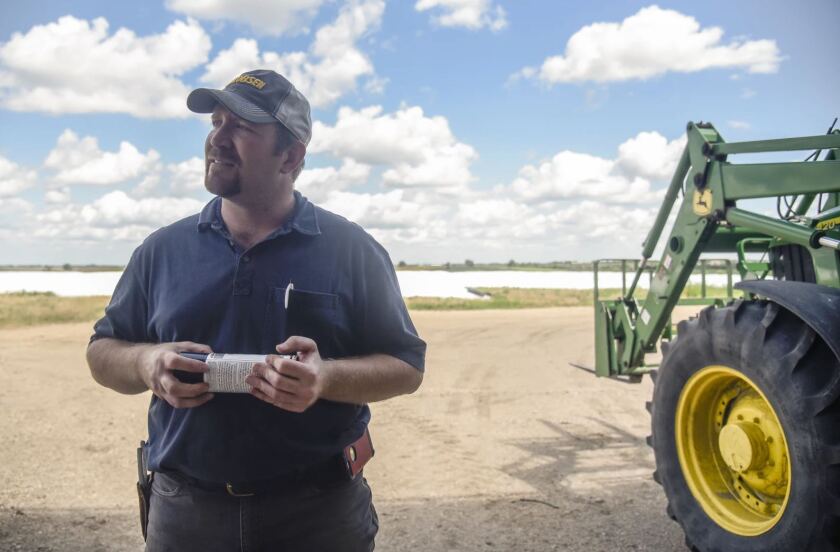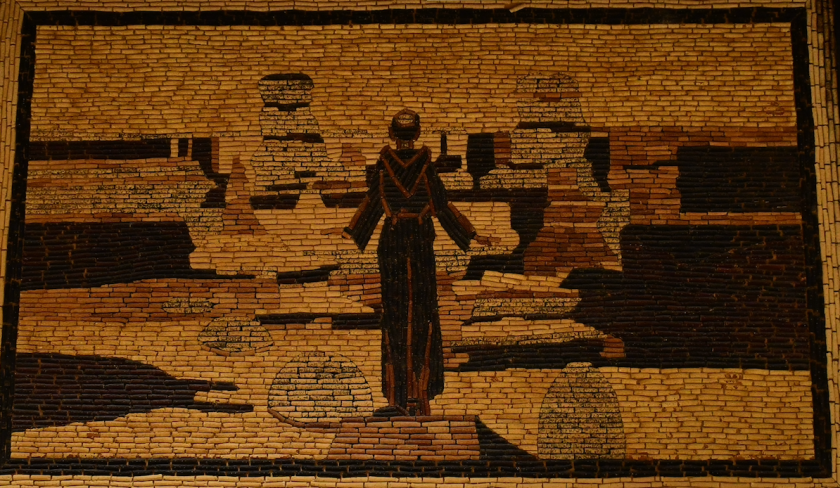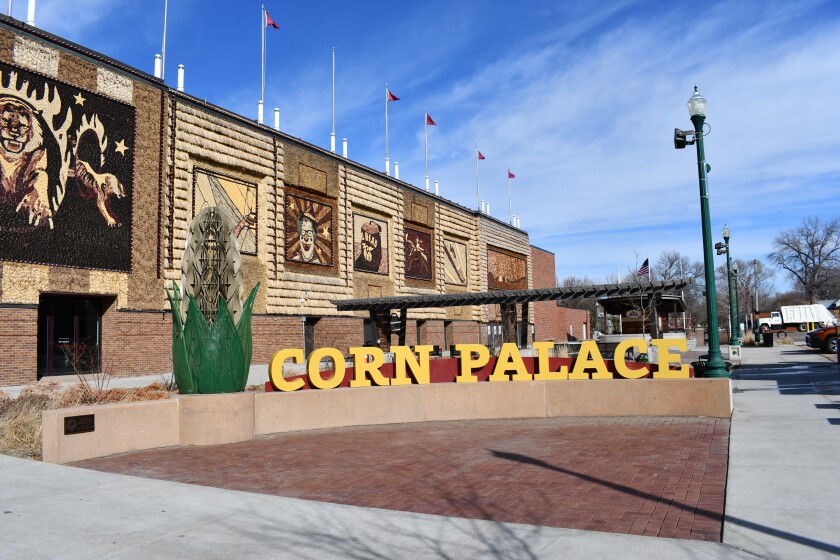It is a long way from a roadside attraction dedicated to corn in southeast South Dakota to the mucilage of a $47 billion corn industrial complex that makes maize barely recognizable as food.
Back in Mitchell, the town of 15,660 that is home to the kernel-adorned temple, adorning the mosaics with all the vibrancy they deserve, at least a dozen different shades of corn must be grown and gathered at the base of the Corn Palace. That is not an easy thing to do. Corn cross pollinates when it is grown in dense proximity. The danger is that corn intended to be red or purple or black will be cross-pollinated with other pigments by the winds of the plains and the result will be variegated, what is usually called “Indian corn.” Wanting to learn more about this, I went to see the provider of the colored cobs, Brett Lowrie, a local farmer.

Lowrie is paid for supplying the corn, of course. The era when local farmers donated the corn to grace the walls of the palace is long over. He is a little sensitive about the cost of the contract, but he assured me that he’d prosper more and save a ton of time and fuss if he just grew the usual field corn of eastern South Dakota. He’s had to buy specialized equipment (“from yesteryear”) to harvest the yields.
Lowrie has had the corn pigment contract for five years. I asked him if he takes pride driving by the Corn Palace knowing that the entire exterior is adorned with corn he grew specially for the project. “Well, maybe for the first year or so,” he said, with a sheepish smile. “But after that and now it’s just a gig.”
I waited to channel my inner Michael Pollan until the end of the interview. As noncommittally as I could, I asked him what he thought about the main lines of the Pollan argument — that we produce so much corn in America that we have to constantly scramble to invent new ways to use it; that the whole corn economy is dependent on government subsidies for a product that has to be taxpayer supported to cash flow; and that in most cases it costs more to produce a bushel of corn than the corn earns on the market — thus requiring subsidy (these days, usually by way of crop insurance) to make up the difference.
He listened politely and did not — as happened when I interviewed a well-known Great Plains Christian conservative radio talk show personality about the same questions a few days later — sputter and denounce Pollan out of hand. Lowrie said, “Well, I grow corn here and am able to make it cash flow.” I had no answer to that. Farmers would not grow corn if on average it did not enable them to make a living by doing so, even if a significant portion of that income comes in support checks from the USDA. Although he was a thoughtful and respectful man, Lowrie made it clear in his quiet way that the larger Pollan arguments don’t worry him much.
He acts locally and doesn’t have much time to think nationally or globally about questions that often seem like abstractions when you’re just trying to make a living. He’s one corn farmer in a state that grows about 5 percent of the nation’s corn. There is an ethanol plant nearby, one of 13 in South Dakota. That’s where he hauls most of his annual harvest. There are 198 ethanol plants in the U.S. and their distribution falls out exactly on state production lines. Iowa has 40, followed by Illinois, Nebraska, Minnesota, Indiana, and then South Dakota.

If you want to get into an argument that will leave you more confused than enlightened, ask farmers and energy experts about the rationality of ethanol — converting corn into fuel for automobiles (and other useful byproducts). Some say it is insane to spend carbon (planting, cultivating, herbicides, fertilizers and pesticides, plus transportation) to grow something that is then converted back into fuel — the same fuel that grew the corn.
Ethanol critics argue that corn production represents not only a net loss of calories (that is, if you add it all up, it takes more energy to produce the ethanol than the ethanol delivers), but also that intensive corn growth is hard on land, unfriendly to wildlife habitat, and a prop to a bloated and highly processed American food industry that is neither healthy nor sustainable. Critics argue that ethanol’s promise as an alternative source of energy and a means toward American energy independence, however well-intentioned, does not hold up to rational scrutiny.
So far from absorbing the pre-ethanol surplus of corn in America, the ethanol industry has resulted in a huge increase in production that further drives down the value of corn. What makes sense in short-term economic terms (Brett Lowrie runs a profitable farm) may not make economic sense if you factor in all the “downstream” costs such as the cost to the American medical system of processed food or the cost of attempts to bring down America’s carbon emissions. Ethanol critics say that if there were no gigantic corn surplus — if the corn we produce was all consumed as food — nobody would have thought to convert it to ethanol. Some recent studies, one funded by the USDA, have suggested that when all the factors have been considered, ethanol may be worse for the environment than oil-based fuels.

Pollan’s arguments are seductive, but it is hard to see how we get to a saner U.S. agriculture from here. About a quarter of America’s arable soil is planted with corn. Whole industries have sprung up in the last half-century to grow corn, store corn, distribute corn, process corn, repurpose corn, export corn, burn corn and feed corn to livestock, not to mention fund corn production. In the last 25 years, the USDA has subsidized American corn production to the tune of $116 billion.
A proposed new corn wet milling plant in Grand Forks, N.D., a Chinese enterprise, will cost $700 million. Fufeng Group, Ltd. plans to process 25 million bushels of corn per year, to produce a corn slurry from which animal nutrition products, fructose corn syrup, pharmaceutical byproducts and something called xanthan gum, used as a food thickener and stabilizer. If constructed, this Fufeng plant, which has run into opposition from Congress and others, will join 24 other corn wet milling plants in the United States. It will employ more than 150 individuals and contract with up to 1,500 local corn growers.
In other words, the corn processing infrastructure continues to grow and find new uses for the miracle grain in the face of rising concerns about America’s health, petrochemical addiction in agriculture, genetic modification, water quality, water scarcity and global climate change. If America gets serious about addressing global climate change, there will have to be a reckoning on the corn paradigm. And yet the ag industry and North Dakota’s elected officials have permitted none of these factors to temper their fulsome praise of the development, which will undoubtedly cause many regional farmers to grow even more corn to meet the demand. The corn economy, like Churchill’s Russia, is “a riddle wrapped in a mystery inside an enigma.”
The World’s Only Corn Palace stands serenely indifferent, quirky and noble at the same time, blissfully untouched by the great American corn debate. The mosaics, particularly those inside the palace, more often than not hearken back to a more innocent and pastoral time in American life. I linger to study the interior panels “painted” by the late Oscar Howe (1915-1983), one of South Dakota’s greatest visual artists. My favorite panels are his spiritual triptych on the south interior wall: on the left, two Native Americans kneeling before a beautiful corn plant, one of them playing the flute with a mystic buffalo silhouetted by the sun behind and over them; on the right, a white man and a Native American kneeling over a camp fire, the Native extending a peace pipe toward the Wašíču (white man), and a horse with a travois over and behind them; and in the middle, Jesuit Father Pierre-Jean De Smet, missionary, peacemaker, advocate for the integrity and sovereignty of Native American culture in the West, and incessant plains traveler. The Blackrobe, as he was known in Native circles, is depicted from behind, standing on a flat rock, wearing his dark cassock, arms spread in the blessing position, looking out onto the badlands of South Dakota in the heart of Lakota (Sioux) country.

(Clay Jenkinson/ Governing)

Read More from the Corn Palace Package
-
The outside mosaics of the Corn Palace change every year, the inside mosaics almost never. A committee meets to choose each year’s theme.










